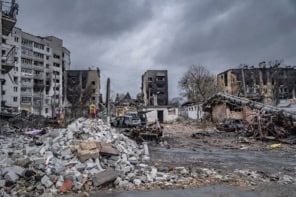Peter Barham became involved with penguin research in tandem with his career in polymer physics. Along the way he has made significant progress in identifying factors that are key to penguin survival
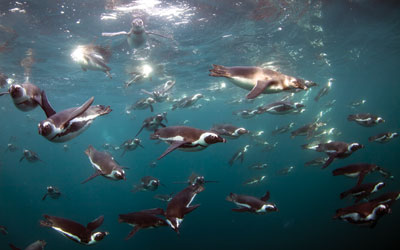
I’m often asked how as a physicist I managed to end up carrying out research on penguins. The answer is it happened through a set of lucky chances driven by my partner’s passion for these animals. When I first met Barbara, it was very obvious that she loved penguins. At first this made my life quite easy as I could always buy her presents she’d appreciate (a book on penguins, a penguin T-shirt or a cuddly penguin). But later in life it got much more difficult – there is a limit to how many penguin-related items are available.
So eventually we started to travel to see penguins in the wild. That led to meeting up with one of the penguin keepers at Taronga Zoo in Sydney who was able to tell us that there would be an international conference about penguins a couple of years later in South Africa. So it was that just over 20 years ago, we took our summer vacation in South Africa so that we could attend the Third International Penguin Conference in Cape Town.
This was my first biological science conference and it made a striking contrast to the physics meetings I had previously attended. It was so polite. No-one offered any criticism of the speakers (even when a rank amateur such as myself could see basic inconsistencies in some talks). If that had happened at one of the polymer-physics meetings I was used to, the speakers would have been eaten alive by some of the old professors in the audience!
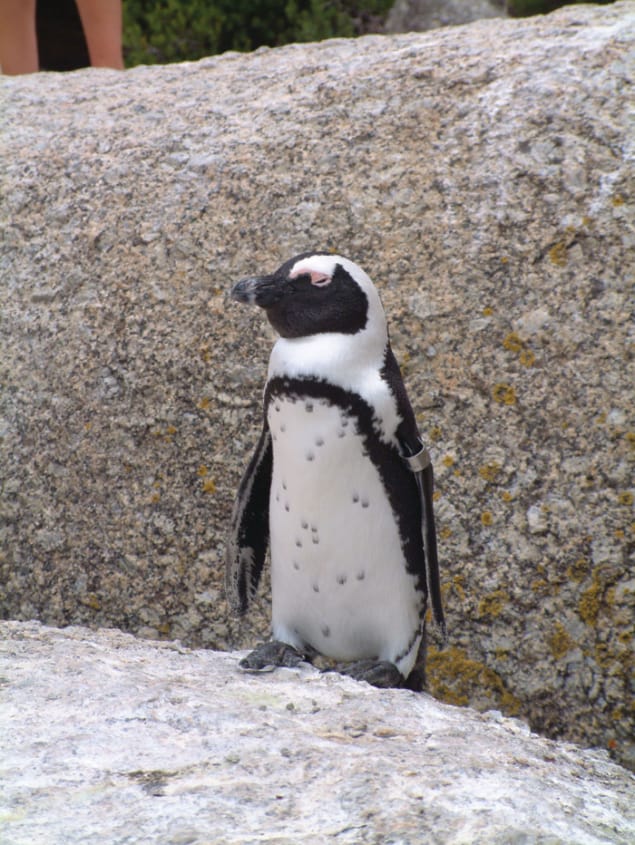
So it came as a real shock to me when halfway through the week a full-on row developed among the biologists after the talk given by one of the leading penguin biologists, Bernard Stonehouse (who was the first person to observe the full breeding cycle of the Emperor penguins through an Antarctic winter). He had decided at the last minute not to give his advertised talk (about interactions between tourists and penguins in Antarctica) but instead harangued the assembled penguin biologists about the way they marked penguins using metal flipper bands.
It had been shown a few years earlier that these bands can adversely affect penguins as they increase the birds’ energy requirements significantly. At the previous International Penguin Conference in 1992 it had apparently been generally agreed that alternative marking methods should be found. Stonehouse had noticed nothing had been done and so made a plea for change. He ended his talk by suggesting that one possible solution might be to use modern materials (such as plastics) to make less harmful bands. Once he finished it seemed everyone wanted to have a say, with many opinions about why plastics were unsuitable – or very suitable – materials.
After a few minutes (and some prodding from Barbara) I decided to intervene and admit that I was a polymer physicist and actually knew something about plastics as materials. Before I knew what had happened I was “volunteered” to develop new plastic flipper bands.
Flipping out
Back at the University of Bristol in the UK, I recruited final-year undergraduate project students to develop the equipment we would need to measure the drag from different styles of bands and to start designing new styles from a range of materials. Within a couple of years we had tested a few designs on penguins at Bristol Zoo and were ready to start testing in the wild – so I set about getting funding for such a project, together with friends I had made during the conference working at the University of Cape Town and the South African Department of Environmental Affairs.
We were lucky enough to get funding from Earthwatch, an environmental charity based in the US, which not only provides money but also volunteers to help with data collection. But just as we were about to start the project, disaster struck.
On 23 June 2000 a cargo ship sank between our chosen research site, Robben Island, and another nearby penguin colony on Dassen Island, both of which lie off the coast of South Africa. More than 360 tonnes of viscous fuel oil was spilled, which led to more than half of the penguins breeding on Robben and Dassen islands being oiled. Those that initially avoided the oil were taken 700 km away to Port Elizabeth and released to swim back while the oil spill was being cleaned up, in order to prevent them getting covered in the black stuff. Nearly all the oiled birds were de-oiled and returned to the islands alongside the translocated birds and it was not until they bred the following year (2001) that we could finally get the project under way.
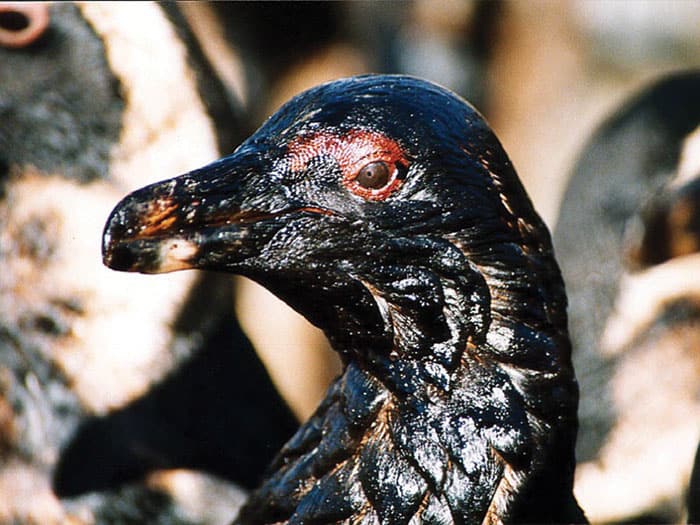
I soon noticed a number of differences between the ways biologists and physicists design and conduct their research. In biology, research is generally hypothesis driven, while in physics it is more commonly curiosity driven. So we had to design our project to test the hypothesis that the “new” plastic flipper bands had no more effect on the penguins than the “normal” steel bands. To do this we fitted pairs of unbanded penguins with the new bands and compared their breeding success to pairs of penguins fitted with traditional bands. Since all the de-oiled and many of the translocated penguins from the oil spill had been fitted with traditional bands, there was no shortage of “control” birds. But we had to search through the colony to find sufficient numbers of breeding pairs of birds, neither of which were already banded, to fit with the new bands. Then it was just a case of letting the volunteers monitor the nests for a couple of years and seeing whether there were differences in the numbers of chicks raised by the two groups.
Once we had three years of data we were able to start analysing whether the new bands were any good. But once I started looking at the data, I kept noticing inconsistencies and issues that did not seem to make sense. So I adopted a “physics” approach and looked for patterns in the data to see if I could tease anything useful out of them.
Quickly I realized that we had captured some unexpected results that had nothing to do with the bands we were trying to test. We found that the birds that had been de-oiled following the spill in 2000 had lower breeding success compared with birds that had never been oiled. We were then able with one more year of data to show a number of surprising conclusions about the whole rehabilitation process for the penguins. We demonstrated that the translocated birds were breeding as successfully as other birds that had never been oiled. This was important as it confirmed that the idea of translocating unoiled penguins (which was an emergency action taken without knowing whether it would work) had indeed been successful.
Another conclusion from the data was that chicks that had been taken away and hand reared before being released had survived better than naturally reared chicks, and were starting to breed well. This was quite unexpected, as received wisdom at the time was that hand-reared chicks were unlikely to survive at all. The de-oiled birds, meanwhile, were raising no more than half as many chicks as the rest.
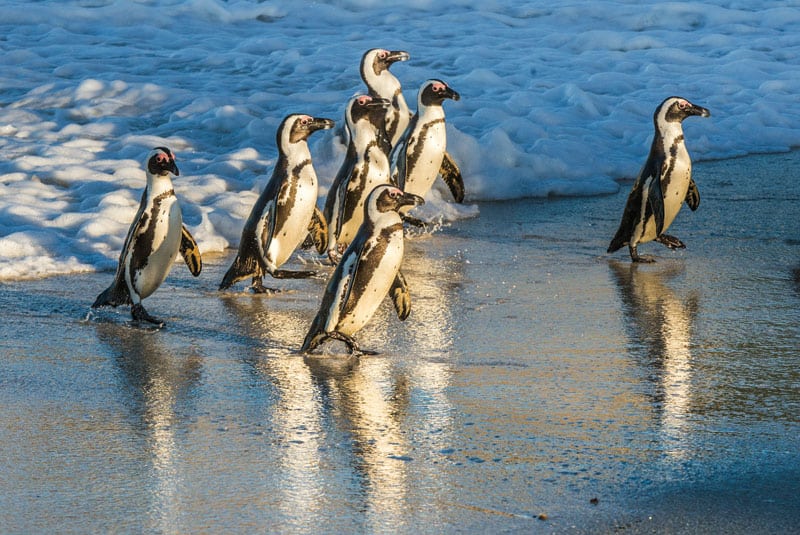
These largely unexpected results have led to changes in the priorities for rehabilitation centres around the world. For example, today in a major oil spill, priority is given first to removing clean birds from the area, to prevent them becoming oiled. In cases where it has been established that hand-rearing chicks is feasible, the second priority is given to removing and rearing these chicks. De-oiling oiled birds, meanwhile, is given a much lower priority. Unfortunately for the original research project, the compounding of effects of bands with effects of de-oiling meant that we were not really able to tell how well the new bands were performing.
At the same time, I had wondered why no-one was using the unique spot patterns on African penguin chests as an alternative means of identification – one that required no bands at all. When I discussed this at a meeting on the advisability of banding penguins, I was astonished to find that the biologists did not realize these patterns were unique to each individual. So I went back to Bristol and enrolled the help of our computer scientists to develop a system to extract patterns from photographs or video footage and automatically recognize individual birds.
We managed to develop a working system that uses computer vision technology. The software first identifies penguins in images streamed from a live video camera and then “cuts out” images that contain enough information to extract the spot patterns. These can later be “indexed” by creating the set of all the vectors connecting each spot to every other spot to create a unique identifier. These sets of vectors can then be compared to a database of all the known penguins to identify each individual bird.
We ran this system for three years on Robben Island, noting the patterns of every penguin that passed a fixed camera along one of the main routes they use to come ashore. But generalizing that to any camera at any location has proved a more challenging task, as the lighting conditions greatly affect the ability of the system to recognize penguins and extract spot patterns. Also, as more and more penguins enter the database, it becomes increasingly difficult to test whether a particular pattern is a match for one already in the system but from a different angle or with a spot occluded by some dirt, or whether it is a bird not yet in the system.
We have, however, been able to get some interesting results from this system just by looking for patterns in the data. For example, it seems that penguins going to sea in the mornings tend to do so in the same groups most days – as if they are a group of school children walking to school with their friends. But in the evenings when they return to their nests they seem to do so in different groups. Why this should be so is still the subject of a lot of speculation.
Food focus
A significant advantage of being in a physics department is that undergraduates have to do final-year research projects and are often interested in practical projects – so they can be persuaded to design and make useful instrumentation for field work, usually involving building electronic automatic data-collection systems. For example, one pair of project students created a battery-operated weighing system using a set of commercially available parcel scales combined with a data collection and control system based around an Amicus microprocessor. Importantly, the system is reliable, robust and cheap enough to be used by field biologists. I supervised a Master’s student who put these weighing systems in front of penguin nests along with camera traps, to weigh and identify penguins as they arrived and left the nest.
This sort of system can not only tell us about how much food the adults are bringing their chicks and how well the chicks are growing, but it can also tell us about how the parents partition the effort of raising chicks, for example. But perhaps the most interesting thing it has taught us so far is that the number one factor in determining how many chicks a pair of penguins will raise is just how well fed the adults are right at the start of the breeding process. We found that if the lighter of the two penguins weighs more than 2.4 kg then the pair are very likely to fledge two healthy chicks. But if it weighs less than 2.0 kg they are unlikely to fledge any chicks at all. These results highlight the importance of the availability of food in the non-breeding season, something that had previously been largely overlooked (probably because it is hard to measure).
Physicists often have crazy ideas – one such idea that came up during a meeting with my colleagues at Bristol Zoo was to conduct an experiment to see if we could create a brand new penguin colony. At the time, African penguins, which breed at around 30 islands and two mainland sites around the western and southern coasts of Namibia and South Africa, were doing quite well. But we thought the birds might not do so well in the future, so if we could try and create a colony now, then we would know how to create new colonies from captive-bred birds should it ever become necessary for the survival of the species.
The idea was generally laughed out of court for all sorts of good reasons. A few years later, however, the population of African penguins started to decline rapidly, largely because the fish stocks started to move away from the coastal waters near the islands where the penguins bred. In 2010 the conservation status of the African penguin was re-classified from “vulnerable” to “endangered”. The once-crazy idea of establishing a new penguin colony is now being actively pursued in South Africa and hopefully in the next few years we will see a colony started in an area where fish stocks are holding up well.
Full circle
The current consensus about flipper bands among penguin researchers is that they are not suitable for African penguins (even the recently developed rubber ones which it turned out some penguins managed to remove by themselves!). Instead, birds are identified either at their nests using the unique pattern markings, or by injecting them with microchips, which have no detrimental effects on their behaviour and are relatively easy to read with suitable equipment.
Three years ago I was the chair of the Eighth International Penguin Conference in Bristol and in September this year I was one of the organizers of the Ninth International Penguin Congress in Cape Town, held exactly 20 years after the meeting that first got me involved with penguin research. At that meeting there was a whole session on post-rehabilitation-monitoring research – all triggered from the observations we made accidentally when trying to evaluate flipper bands. So my work has come full circle and although I still consider myself a physicist, I have also become accepted as a real penguin biologist.
- See below for a video of Peter Barham explaining how you recognize a penguin in a crowd, as part of Physics World’s 100 Second Science series.

